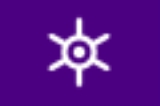
Insignias of Tokyo
Encyclopedia
Tokyo Metropolis
has two official emblems. One is called the crest or monshō, another is called the symbol. It also has two official flags featuring either emblem.
 The was adopted on November 2, 1943, under the . It is same as the Crest of the former Tokyo City
The was adopted on November 2, 1943, under the . It is same as the Crest of the former Tokyo City
, decided by the city council on December 1889. It is believed to be designed by , an alderman of the city.
The crest shows the Sun with six rays, representing Tokyo as the center of Japan. As most other prefectural crests in Japan, its color is not designated. The crest looks like a kanji
京 (kyō) of 東京 (Tokyo), but the metropolitan announcement does not explain as such.
which was popular in Edo
.
 The was adopted on June 1, 1989, under the .
The was adopted on June 1, 1989, under the .
The design was selected by the from 20 candidates. The winning design was created by , a professional graphic designer.
The vivid green symbol features the letter T for Tokyo. It shows dynamism, prosperity, affluency, and relaxation of the metropolis for future. The symbol looks like a leaf of gingko, the metropolitan tree. However, neither the metropolitan announcement nor the Japanese official website explain as such.
On the other hand, the Metropolitan Symbol and the Metropolitan Symbol Flag are more commonly used, including its official website, the metropolitan-operated buses and trains.
} 都の紋章・花・木・鳥 (Metropolitan crest, flower, tree and bird)
} Tokyo's Symbols
} 東京都例規集データベース (Tokyo Metropolis ordinance database)
Tokyo
, ; officially , is one of the 47 prefectures of Japan. Tokyo is the capital of Japan, the center of the Greater Tokyo Area, and the largest metropolitan area of Japan. It is the seat of the Japanese government and the Imperial Palace, and the home of the Japanese Imperial Family...
has two official emblems. One is called the crest or monshō, another is called the symbol. It also has two official flags featuring either emblem.
Metropolitan Crest

Tokyo City
was a municipality in Japan and part of Tokyo-Fu which existed from May 1, 1889 until its merger with its prefecture on July 1, 1943. The historical boundaries of Tokyo City are now occupied by independent special wards...
, decided by the city council on December 1889. It is believed to be designed by , an alderman of the city.
The crest shows the Sun with six rays, representing Tokyo as the center of Japan. As most other prefectural crests in Japan, its color is not designated. The crest looks like a kanji
Kanji
Kanji are the adopted logographic Chinese characters hanzi that are used in the modern Japanese writing system along with hiragana , katakana , Indo Arabic numerals, and the occasional use of the Latin alphabet...
京 (kyō) of 東京 (Tokyo), but the metropolitan announcement does not explain as such.
Metropolitan Flag
The was adopted on October 1, 1964, under the . It features a white Metropolitan Crest on center. The background color is , a traditional colorTraditional colors of Japan
The traditional colors of Japanare a collection of colors traditionally used in Japanese Literature, textiles such as kimono, and other Japanese arts and crafts.-History:...
which was popular in Edo
Edo
, also romanized as Yedo or Yeddo, is the former name of the Japanese capital Tokyo, and was the seat of power for the Tokugawa shogunate which ruled Japan from 1603 to 1868...
.
Metropolitan Symbol

The design was selected by the from 20 candidates. The winning design was created by , a professional graphic designer.
The vivid green symbol features the letter T for Tokyo. It shows dynamism, prosperity, affluency, and relaxation of the metropolis for future. The symbol looks like a leaf of gingko, the metropolitan tree. However, neither the metropolitan announcement nor the Japanese official website explain as such.
Metropolitan Symbol Flag
The was adopted on September 30, 1989, under the . It features a vivid green Metropolitan Symbol on center. The background color is white.Usages
Both emblems and their corresponding flags are the official insignias of Tokyo. The Metropolitan Crest and the Metropolitan Flag are older and are used on more formal occasions.http://www.metro.tokyo.jp/ENGLISH/PHOTO/2008/080301.htm http://www.metro.tokyo.jp/ENGLISH/PHOTO/2007/071002.htm They are also used on traditional or historical objects, as well as the things of the longer duration of use.On the other hand, the Metropolitan Symbol and the Metropolitan Symbol Flag are more commonly used, including its official website, the metropolitan-operated buses and trains.
See also
- List of Japanese flags
- List of municipal flags of Tokyo Metropolis
External links
} 都の紋章・花・木・鳥 (Metropolitan crest, flower, tree and bird)
} Tokyo's Symbols
} 東京都例規集データベース (Tokyo Metropolis ordinance database)

